Stepping into a business with an established SaaS framework, but no B2B Saas segmentation strategy, can feel like wandering into an exhibition of abstract art. Segments in every direction, some complex, some bare, some overlapping. Clouding your vision with a myriad of hues. Intimidating, isn’t it?
Now imagine this; distilling that complex cacophony into cohesive, intuitive segments. A mosaic that makes business sense. Each piece meticulously calculated to form a striking, streamlined panorama of strategic opportunities. That’s the power of B2B SaaS segmentation – a precise art backed by data and research.
It’s an aspect often overlooked but its impact is monumental. Welcome to a treasure trove of 5 proven strategies that’ll enable you to slice through the clutter and tailor a holistic B2B SaaS segmentation model, rooted in exhaustive research. Be ready, it’s time to redefine the way you manage and leverage your SaaS services.
SaaS Customer Segmentation
- Discover the power of SaaS customer segmentation
- Learn its significance in business growth
- Case studies showcasing successful SaaS customer segmentation
Understanding the Concept of B2B SaaS Customer Segmentation
SaaS customer segmentation is more than just a fancy term – it’s the hidden treasure in the world of B2B marketing. This concept involves dividing a company’s customer base into distinct groups that share similar characteristics, such as industry, company size, or product usage.
Moreover, it’s far from one-size-fits-all. SaaS customer segmentation can be categorized into several types, ranging from demographic to behavioral. Each has its unique approach and provides diverse insights, paving the way to tailor-made marketing strategies.
Real-life Examples of Successful B2B SaaS Customer Segmentation
As they say, proof is in the pudding. Several SaaS giants owe a great deal of their success to effective customer segmentation. Here are a few illuminating examples.
Adobe’s Creative Cloud: Catering to Distinct Customer Segments
Adobe’s Creative Cloud is a prime example of SaaS customer segmentation. They cater to a host of different customer sets, from students and photographers to large businesses. The segmentation allows them to tailor product offerings and pricing models to each group.
Now, Adobe goes one step further. Within their main customer segments, they further break down different use cases for different individuals within those segments, offering endless different pricing plans to suit each need.
Below, you can see this breakdown in their user plans. This means Adobe caters for just about everyone, widening their audience and improving customer satisfaction.
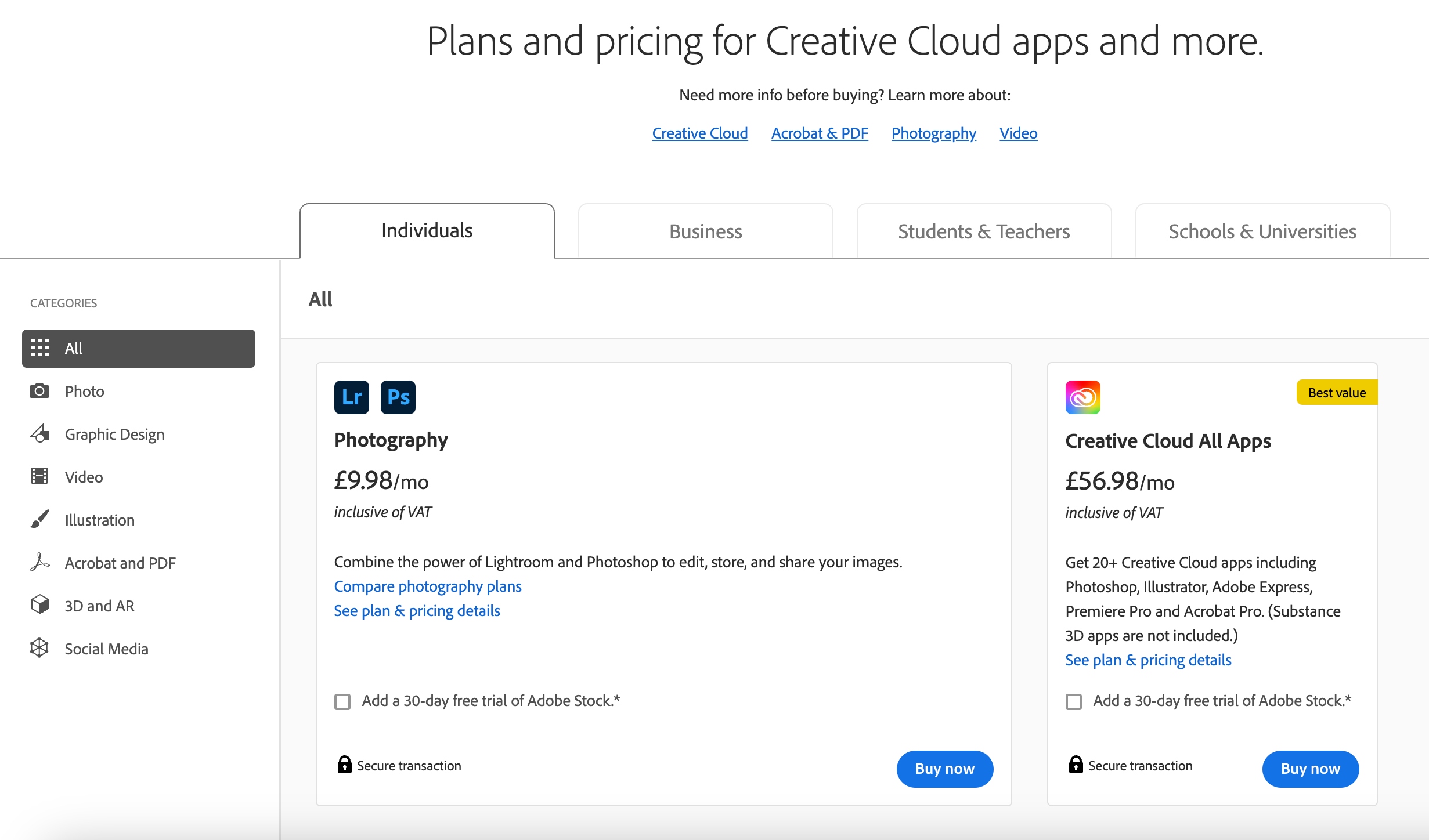
Slack: Understanding the Individual Needs of Users
Slack’s success lies in their ability to understand and cater to their diverse user base. They have done a commendable job of segmenting customers based on the users’ specific needs and use cases, leading to a highly personalized user experience.
As you can see below, they make their different use cases clear on website by segmenting their solutions to different departments and industries.
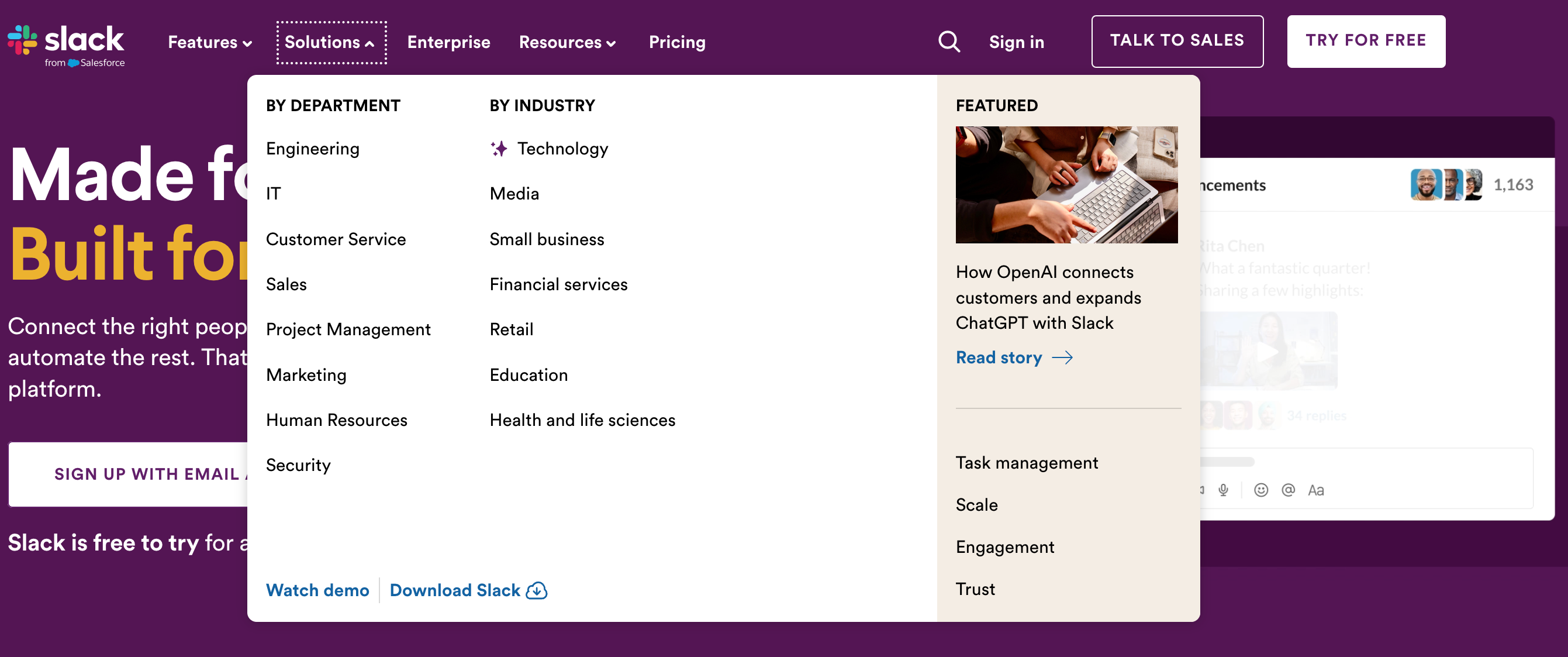
By drawing learnings from such potent examples, SaaS businesses can harness the power of customer segmentation to drive growth and performance in their respective industries.
B2B SaaS Growth Strategies: The Role of Segmentation
- The proven relationship between segmentation and sustained business success
- Viable approaches to meaningful, actionable segmentation
- Corporate success story on leveraging segmentation
How Segmentation Fuels B2B SaaS Growth
Smarter segmentation unearths the gold on your client base, boosting B2B SaaS growth. It’s more than grouping customers on obvious lines; the real power lies in careful, strategic segmentation based on customer behavior, needs, and product interaction. Failures of a ‘one-size fits all’ strategy attest to the efficiency of a segment-specific approach, pushing businesses to optimum revenue growth.
To put things into perspective, imagine sitting at a restaurant. The waiter throws a menu at you that’s as lengthy as a novel. Overwhelming, isn’t it? You wish someone had parsed the options down to a digestible, targeted list.
In the B2B SaaS realm, segmentation plays that saviour. By tailoring your software solutions for specific user groups, you:
- Bolster product relevance
- Enhance user experience
- Solidify customer relationships
All of which drive long-term growth.
Special attention to segmentation in the case of customer churn can be enlightening. An in-depth evaluation of the spectrum of customers leaving your service might reveal hidden patterns or common reasons. It’s these seemingly inconspicuous findings that have the power to dramatically augment customer retention and foster consistent growth.
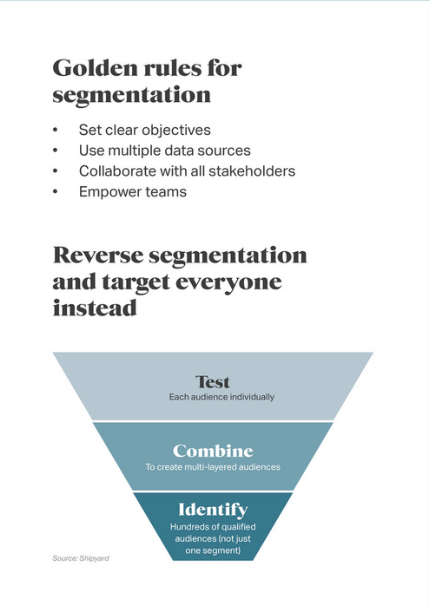
Key Segmentation Strategies for B2B SaaS Businesses
Leveraging segmentation for growth requires a tactical approach. A few effective strategies include:
- Value-based segmentation: This method arranges customers by their economic value. This is how businesses prioritize efforts on high-value clients while strategically marketing to lower-value groups for potential uplift.
- Behaviour-based segmentation: This method clusters customers based on their product interaction and behaviour. Usage patterns, previous buying behaviour, and product preference come into play here.
- Industry-specific segmentation : This method classifies clients based on their industry. This allows B2B SaaS enterprises to tailor software features catering to particular industries, boosting product relevance and customer satisfaction.
Each strategy boasts unique merits and serves a specific purpose. Fusing them adroitly caters for a comprehensive segmentation model that’s both actionable and profitable.

Case Study: iSpionage – Leveraging Segmentation for B2B SaaS Growth
iSpionage, a tool that provides AdWords competitor keywords and monitors competitor PPC landing pages, utilized onsite retargeting to increase blog referral traffic by 58% in one month. They employed OptiMonk exit-intent popups, which were only shown to readers who had spent a minimum of ten seconds on the blog.
This personalized engagement, combined with limiting the popup appearance to a maximum of five times for repeat visitors, significantly improved visitor experience and increased traffic. This case demonstrates the power of targeted, behavior-based segmentation in enhancing SaaS business growth. Check out the difference below in just once month!

Case Study: G2 – Saas Segmentation and Targeting
Another example is G2, a leader in business software reviews, which utilized deep keyword research, comprehensive content generation, and widespread outreach efforts. Starting with their blog, they expanded their traffic from 50,000 sessions to nearly 1 million sessions within a year.
This growth was attributed to their strategic approach in content creation and distribution, but the key here was their keyword research strategy. To segment their audience and the kind of quieries they were searching, they went straight to specific competitors to see what they were targeting.
The success of this technique demonstrates the effectiveness of well-thought-out segmentation and targeting strategies in the SaaS sector. Check out their progress below.

Actionable Customer Segmentation: A Game Changer for B2B SaaS
TL;DR
- Definition and application of Actionable Customer Segmentation
- Calculate and apply your own customer segmentation strategy
- The domino effect of the right segmentation strategy on customer retention._
What is Actionable Customer Segmentation?
Allow me to introduce a game-changer for B2B SaaS companies – actionable customer segmentation. It’s a powerful strategy that places customers into groups that share similar characteristics, such as:
- Company size
- Customer type
- Behavior
This presents opportunities for specific marketing and customer relationship activities.
Interesting, right? Now imagine using these groups to streamline your marketing efforts and increase conversion rates. That’s right – it’s no daydream. It’s the reality of actionable customer segmentation.
Steps to Implement Actionable Customer Segmentation in B2B SaaS
- Identify customer characteristics: The first pivotal step is to identify what characteristics define your customer groups. This will determine the basis of your segregation-whether it’s behavioural attributes, demographic segmentation, or purchasing habits.
- Segment: Once you’ve identified defining characteristics, the next step is the creation of segments. These segments will allow for more targeted marketing strategies and customer service initiatives.
- Action: The final step is where the magic happens-when you take your new segmentation and apply it to your SaaS strategies. Tailored marketing campaigns, personalized customer service initiatives, and focused product development are just a few ways you can put your fresh segmentation into action.

The Impact of Actionable Customer Segmentation on Customer Retention
Actionable customer segmentation isn’t just a buzzword, it’s a proven method to improve retention. How does it work? Well, each customer segment has unique needs and wants. Catering to these through tailored marketing efforts, personalized service, and focused product development, companies can provide a higher degree of customer satisfaction.
Satisfied customers are more likely to stick around and even become brand evangelists, promoting your business to their network. So, the work done in segmentation essentially challenges the adage that all good things must end. With the right segmentation, customer relationships can last-and flourish.
While the process might sound complex, the potential reward for your SaaS business is undeniable. So, let’s not be bystanders. The world of SaaS is ever-evolving and to stay in the game, let’s shake hands with actionable customer segmentation and the myriad of benefits it brings along.
SaaS Segmentation Best Practices: A Guide for B2B Businesses
- Adopting top SaaS segmentation best practices
- Averting the usual pitfalls in SaaS segmentation
- Harnessing expert tips for effective SaaS segmentation
It’s obvious that actionable customer segmentation has opened a new horizon for B2B SaaS. Advancing this concept, it becomes crucial to make these segmentation efforts more directed and on point. Let’s dissect a hands-on guide for SaaS segmentation best practices, common mistakes to avoid, and expert tips.
Top 3 SaaS Segmentation Best Practices
A database is not just a storage facility; it’s a valuable goldmine waiting to be explored. In the world of SaaS, precise segmentation can uncover hidden opportunities. What are the best practices that guide this focus? Here are the top 3:
- Understand the distinctions in your customer base: Differentiation is the key, and that’s where factors like behavioral aspects, usage patterns and demographic data come in. Remember, one pattern does not fit all. Keep an eye on the changing dynamics and adjust your approach accordingly.
- Prioritize data: The best segmentation efforts can fall flat in the absence of robust data management. Where possible, collect as much relevant data and consolidate it into a unified platform for ease of access. The value of clean, organized information can’t be overstated when it comes to meaningfully segmenting your customers.
- Consider personalization at scale: Customizing product experiences isn’t just for small customer sections. By leveraging automation and machine learning, personalization can be achieved for larger demographics, bridging the gap between scale and customization.
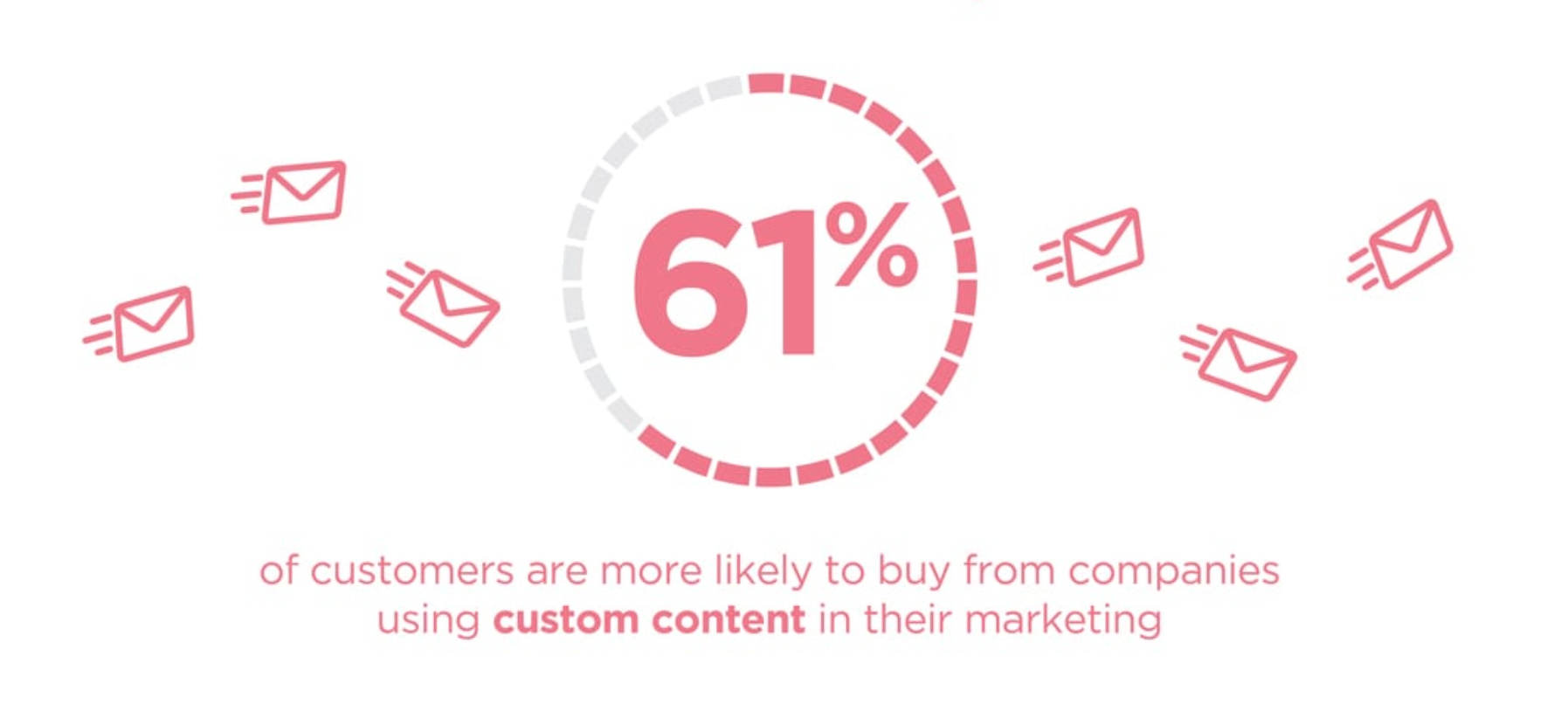
2 Common Mistakes to Avoid in SaaS Segmentation
Unfortunately, the path to successful segmentation has its traps. The two most important ones to keep in mind are:
- Segmenting based on hypothetical personas rather than actual customer data. The assumption can lead to faulty decision-making and missed opportunities.
- Not updating the segmentation structure to evolve with changing customer habits or market dynamics. Flexibility in your approach is non-negotiable; allowing your segmentation model to be a relic of the past while the world around you changes is a surefire way to lose out on valuable insights and opportunities.
3 Expert Tips for Effective SaaS Segmentation
Success in SaaS segmentation isn’t simply about avoiding mistakes; it’s also about using actionable tips from industry experts. Here’s our personal top 3:
- Focus on customer lifecycle and engagement metrics: Understanding when and how customers engage with your product can be transformative. Track usage, analyze interactions, and gain a comprehensive view of customer journeys.
- Leverage technology for precision: Today’s tools facilitate microsegmentation that can unlock vital customer insights. They allow segmentation by specific behavioral indicators, creating richer, more nuanced customer profiles.
- SaaS segmentation isn’t a one-time activity; it’s a continual process: Dedicate time to regularly review, analyze, and adapt your segmentation strategy to maximize its potential.
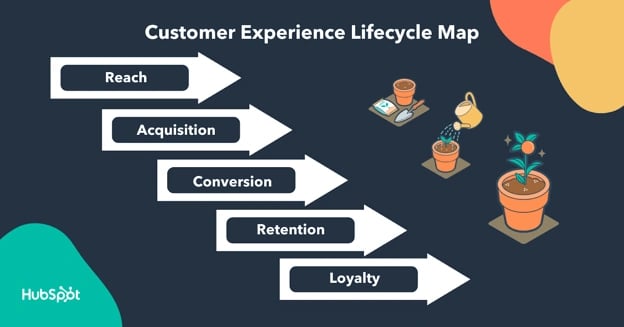
Value-Based Segmentation in B2B SaaS: The Future of Customer Segmentation
- Value-based segmentation’s power and impact in B2B SaaS
- The irresistible benefits of utilizing this strategy
- Proven tactics for successful implementation in your company
Understanding Value-Based Segmentation
Value-based segmentation, a practical approach in SaaS B2B model, roots its principles in assessing an individual customer’s value to your organization. The grand idea here is to categorize your customers based on their revenue-generating potential, rather than demographic categories or superficial attributes.
The fundamental core of value-based segmentation banking directly on comprehending your clients’ engagement and interaction with your product. By putting the magnifying glass on individual usage and habits, business decisions become more customer-focused and driven by practical insights rather than assumptions.
Admittedly, this shift, from a more top-line focused approach to a customer-centric model can seem daunting. Still, the significant uplift to your company’s bottom line and customer satisfaction metrics will prove its worth in the long run.

The Benefits of Value-Based Segmentation in B2B SaaS
By merging financial data with customer engagement analytics, value-based segmentation offers an in-depth understanding of your user base. This method considers customer lifetime value. You’re prompted to ask crucial questions, What are the high-revenue behaviors? Who are your most valuable customers?
While every competent business recognizes customer retention as fundamental, the focus here is more on the substantial profit contributors. You aim to retain your high-value users and adjust your strategies to transform your low-value users into top-paying customers.
This dual approach not only maximizes your revenue but also consolidates customer loyalty.
In the ever-competitive landscape of SaaS B2B, value-based segmentation also helps frame brand differentiation strategies. Your positioning becomes distinct, based on addressing client needs and preferences rather than building on industry averages, helping you stand out in a saturated industry.
How to Implement Value-Based Segmentation in Your B2B SaaS Business
Understanding is one thing, actual implementation is another. How do you successfully execute value-based segmentation in your business? There are two main steps:
- Analyze your existing customers: Find common characteristics among your high-value users, scrutinize their behavior and engagement with your product. Are there unique features they frequently use? What becomes recurring is the indication of what’s valuable.
- Evaluate your monetary data: Analyze the revenue, cost data, churn rates and other financial indicators related to each customer or customer groups. The key here is to identify the profitable behaviors and interaction patterns to lay a foundation for future segmentation strategies.
Remember that value-based segmentation is not a one-time, static process but rather a dynamic, continual adjustment. In the ever-evolving world of B2B SaaS, stay responsive to changes. Iteratively refine your segments backed by updated data and new insights. Your go-to-market strategy should continuously evolve following these new patterns and discoveries.
Supplementary Information
- Grasp what B2B SaaS is and why it’s essential
- Understand the importance of customer segmentation in SaaS
- Study how customer segmentation in SaaS has evolved over time
- Learn about the role of AI and Machine Learning in SaaS segmentation
- Anticipate future trends in B2B SaaS Segmentation
What is B2B SaaS?
B2B SaaS, or Business-to-Business Software as a Service, is a cloud-based software model where providers license software applications to businesses on a subscription basis.
These solutions are typically centrally hosted and readily scalable to meet growing business needs. The SaaS model has transformed the way businesses operate, driving efficiencies, reducing costs, and enabling scalability like never before.
The Evolution of Customer Segmentation in SaaS
From a one-size-fits-all strategy, customer segmentation in SaaS has significantly evolved, embracing personalized experiences and product offerings. Businesses no longer view their customers as a homogenous group but as distinct segments with varying needs, pain points, and usage patterns.
This paradigm shift has empowered SaaS providers to fine-tune their offerings and marketing efforts, driving customer satisfaction, engagement, and ultimately, business success. This can be largely attributed to the introduction and accessibility of artificial intelligence for SaaS businesses. Analyzing huge data sets and gaining valuable insights from them can now be done in a matter of minutes.
The Role of AI and Machine Learning in SaaS Segmentation
Artificial intelligence and machine learning have been game-changers in SaaS segmentation. These technologies enable businesses to profile and segment customers accurately, based on a thorough analysis of usage data, behavioral patterns, and feedback.
AI and ML are effectively bringing about predictive segmentation, allowing SaaS businesses to anticipate customer needs and tailor their offerings proactively.
Future Trends in B2B SaaS Segmentation
As businesses continually adapt to changing customer needs and market dynamics, innovative trends emerge in B2B SaaS segmentation. One such trend is micro-segmentation, where customers are grouped into highly refined and specific segments.
Similarly, voice of customer (VoC) data is gaining importance in segmentation. Looking ahead, advancements in AI and machine learning will continue to push the envelope, bringing about more accurate and dynamic segmentation strategies in the B2B SaaS space.
Wrapping Up With an Action Plan
Pinpointing key markets, identifying value-based and needs-based segments, operationalizing your segmentation efforts, measuring success, and leveraging scalable technology: these are your keys in the complex world of B2B SaaS segmentation.
The value? By dialing into these strategies, you can push your SaaS offering to the forefront. Precision, relevance, and personalization become your unique selling points in a crowded market.
Now for your mission: apply these strategies in your B2B environment. Begin by identifying your most valuable customer groups. Where can you add immense value? What unmet needs can you fulfill? Draw out the roadmap. Start small, measure the outcomes, iterate.
Have you identified any unusual, unique B2B segments in your sector? Could you share how these distinct segments have impacted your marketing strategy?
Go ahead, embrace the power of strategic market segmentation. Distinguish your SaaS - become indispensable.
FAQ: B2B SaaS Segmentation Strategies
Q1: What is SaaS customer segmentation?
A: SaaS customer segmentation involves dividing a business’s customer base into distinct groups sharing similar characteristics, such as industry, company size, or product usage. This strategy helps tailor marketing efforts and product development to meet the specific needs of different segments.
Q2: Why is customer segmentation important for SaaS businesses?
A: Customer segmentation is crucial for personalizing marketing strategies, improving customer service, enhancing product development, and ultimately driving business growth. It helps SaaS companies understand their customers better, leading to higher satisfaction and retention rates.
Q3: What are the common types of customer segmentation in SaaS?
A: Common types of SaaS customer segmentation include demographic, behavioral, psychographic, and value-based segmentation. Each type offers different insights and helps tailor strategies to specific customer groups.
Q4: How does segmentation impact business growth?
A: Segmentation allows SaaS companies to focus their resources on the most profitable customer segments, personalize their offerings, improve customer retention, and effectively scale their marketing and sales efforts.
Q5: Can you provide real-life examples of successful SaaS customer segmentation?
A: Companies like Adobe with its Creative Cloud and Slack with its varied user base have successfully used customer segmentation to cater to different customer needs and significantly improve engagement and growth.
Q6: How can I start implementing customer segmentation in my SaaS business?
A: Begin by collecting and analyzing customer data to identify distinct groups within your customer base. Consider factors like usage patterns, purchase history, and customer feedback. Then, tailor your marketing and product strategies to meet the specific needs of each segment.
Q7: What challenges might I face with SaaS customer segmentation?
A: Challenges include collecting and analyzing sufficient data, ensuring data privacy, keeping up with changing customer behaviors, and creating targeted strategies that effectively address the needs of each segment.
Q8: How often should I review and update my customer segmentation strategy?
A: Review and update your segmentation strategy regularly, at least once a quarter, to ensure it remains relevant and effective as your customer base and market conditions change.
Q9: What tools can help with SaaS customer segmentation?
A: Tools like CRM software, analytics platforms, and marketing automation tools can help collect and analyze customer data, identify segments, and implement targeted marketing strategies.
Q10: How do I measure the success of my segmentation strategy?
A: Measure success by tracking key performance indicators (KPIs) such as engagement rates, conversion rates, customer retention rates, and overall revenue growth attributable to each customer segment.

